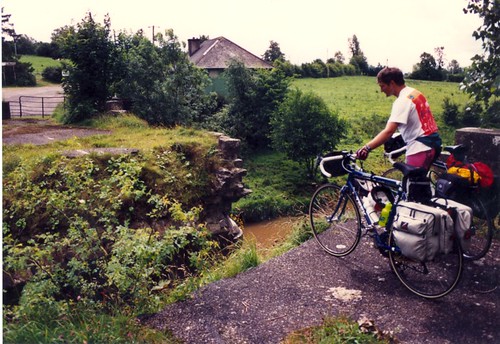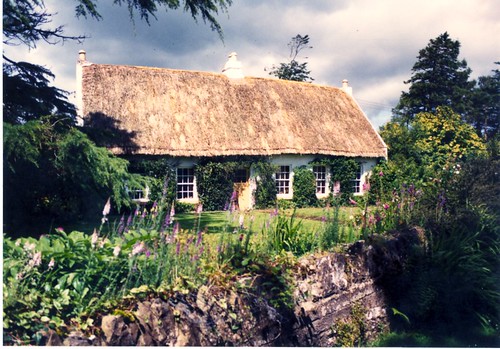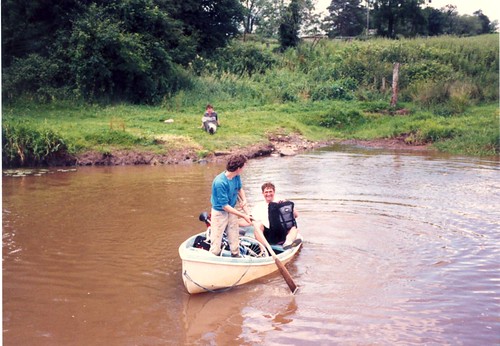Eight years before the Good Friday Agreement and well before the rise and fall of the Celtic Tiger, my friend Rich and I rode a thousand miles around Ireland.
At the time we traveled, “The Troubles” were considered one of the world’s intractable conflicts, and from the east coast of the United States, Northern Ireland appeared to be a dangerous war zone.
Still, we felt it was important to at least get a taste of life in Ulster.
From Sligo in County Donegal we rode north, turning east at Ballyshannon. As we approached the border, we saw a British army officer next to a small shack. He waved us through.
About three miles further on, we came to a checkpoint. The road was heavily blockaded and closed off to one lane. Another officer, in full field gear, stood near a heavily fortified bunker (complete with camouflage and a gun turret). He was searching cars before allowing them to pass through.
The officer waved us through without bothering to search us, and soon we were making good time on the best paved road we’d been on in Ireland.
After spending an uneventful night in Enniskillen, the site of a notorious Remembrance Day bombing in 1987, we mounted our bikes for what appeared on our map to be a twelve mile ride to Cavan, back in the Republic.
A few miles out of town we saw a sign that read, “Barrier, 2 miles ahead,” and we knew something was amiss.
I thought back to the B&B owner’s directions: “Follow the signs to Swanlinbar, then pick up the road to Cavan.” Of course we didn’t listen. Swanlinbar was out of the way; we’d seen a more direct route to Cavan through Teemore.
When we approached the barrier it was laughable: a couple of oil drums filled with gravel. We stopped for a picture.
We went around the barrier and followed what was left of the road for 20 yards, then stopped dead. Where there once was a bridge, there was nothing. A gap of 35 feet between two stretches of road (with a river below) insured that illegal border crossings at this point would not be possible.
We had no option, it seemed, except to return to Derrylin and take the road around to Swanlinbar. This detour was going to turn our short day into a long one.
As we walked our bikes back to the paved road, we passed a beautiful thatch-roofed house. A woman, in her early 50s, sat in the front yard picking berries off some stalks she had cut.
“Illegal?” she said. We walked over to her stone fence.
“What?”
“An illegal crossing, yes? The road doesn’t go through anymore.”
We told her that on our map it appeared as though it did go through, but we would ride back to Derrylin and go around to Cavan.
“If you like, you can wait for my boys to come home for lunch. And then they’ll take you across in the boat.”
She assured us this sort of thing happened all the time and that it would be no problem. “At least a dozen people a day come to the end of this road, only to find it doesn’t go through.”
She invited us into the yard and we sat down at a picnic table with her as she pulled the berries from their stalks. “This used to be the main road from Donegal to Dublin, but the bridge was blown up in 1972 by terrorists.”
She paused, then continued, “This house was built in 1720. It’s the original structure. We just had the roof re-thatched. You know, they’re building thatch-roofed houses in Ireland now for tourists, but this house has been as it is since the 1700s.”
She told us about the thatching of the house and some local history and sites and then invited us inside for a look at the house and a cup of tea.
She took us into the parlor first. The room was dark with a low ceiling and uneven floors. It was filled with antique furniture. The mantle piece to the fireplace was lined with photographs that had been dry-mounted. “Is someone in the house a photographer?” I asked.
“I am,” she said. “I’ve done a lot of photographic studies of the canal and of wildflowers in the area. But this is my favorite.”
She picked up a portrait of an old cobbler at work in his shop. “He lives down the road in a one-room house. He has his fire, his tools, all his belongings surrounding him. He has one window that looks out onto the road and one beam on the house where he stores all his nails. He sits by that window and works all day.”
She paused again, lost in thought, then turned and said, “Come this way.”
She took us through the rest of the house and finally to the kitchen where she made us a cup of tea. She said, “This used to be quite a busy road, but since they blew up the bridge, it’s been a quiet part of the world.”
“When was the bridge blown up?” I asked.
“It was first blown up in November of 1972. Those were frightening times. There had been five murders in the area. The local priest was shot in his home and so was a schoolteacher. They shot a school bus driver in his bus and two of our neighbors were killed in their homes. The IRA was coming across the border, you know.
“Then one night, there was a knock at our door. I hid the three young ones and I prayed they weren’t coming to kill my husband. There were three men wearing black masks. They told us to get out of the house, that they were going to blow up the bridge.
“We took the children and went up the hill, and sure enough, they blew the bridge. Protestant extremists, you know, trying to stop the IRA raids across the border.
“After that, the Republic put down a temporary metal bridge. But the trouble started again. One night we heard people outside. It was men in black masks again. I tried to call the security forces, but they had cut the telephone wires. They do that, you know.
“We hid in the house and, shortly, we heard the explosion. Pieces of wood and metal fell all over the yard. It blew our windows out. But this house is so old it has the wooden shutters. We just closed the shutters and went back to sleep.”
“Are things any better now?” I asked.
“Well, sometimes, I start to think so. But then something happens. We have a cross-community group and we try to work things out. A few months ago, we were going to have a big meeting with our local MP and the Minister for Rural Development. Of course, you can’t tell anyone when a Minister is coming. It’s too dangerous.
“We asked a local restaurant owner if we could meet at his place. We had to tell him a Minister was coming because of the danger. He said we could meet at his restaurant.
“The meeting went well, but a few days later, a bomb exploded in his restaurant. He was a Catholic, too. But they don’t want you to even cooperate with the government to find a solution. Sometimes, I don’t think they want a solution.
“Saturday, the farmers in the area are having a big protest because they want the bridge rebuilt. But I don’t know what will happen. All I know is that this house has been here a long time and it will be here for a long time to come whether there’s a bridge or not,” she said.
She heard a truck coming down the lane. “Here come the boys now. They will take you across the river.”
After we said our goodbyes, two of her sons ferried us and our bikes across the river, one at a time. We then carried our bikes across a field, over a fence, and back onto the road where the bridge had been.
We headed off for Cavan, 10 miles down the road.



